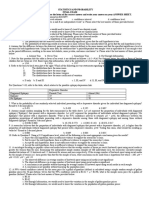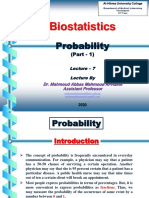0 ratings0% found this document useful (0 votes)
13 viewsSTT034 - 7 Conditional Probability
Uploaded by
Anne QuillaCopyright
© © All Rights Reserved
Available Formats
Download as PDF or read online on Scribd
0 ratings0% found this document useful (0 votes)
13 viewsSTT034 - 7 Conditional Probability
Uploaded by
Anne QuillaCopyright
© © All Rights Reserved
Available Formats
Download as PDF or read online on Scribd
You are on page 1/ 3
Rules of Probability Let A and B be any events.
1, Addition Rule: P(AU B) = P(A) + P(B) ~ P(AN B)
2. Complement Rule: If A’ is the complement of A, then P(A’) = 1— P(A).
5.1 Conditional Probability
Definition, The The conditional probability of A given B is defined as
P(ANB)
P(AIB) = Say
whereP(B) #0.
Example. The primary aim of a study by Carter et al. (AI) was to investigate the effect of the age
at onset of bipolar disorder on the course of the illness. One of the variables investigated was family
history of mood disorders, Table 3.4.1 shows the frequency of a family history of mood disorders in
the two groups of interest (Early age at onset defined to be 18 years or younger and Later age at onset
defined to be later than 18 years)
TABLE 3.4.1 Frequency of Family History of Mood Disorder by
Age Group among Bipolar Subjects
Family History of Mood Disorders Early= 1816) Later > 19) Total
Negative (4) 28 % 3
Bipolar disorder (6) 18 B a
Unipolar ic) a “4 25
Unipolar and bipolar (O) 53 o a3
Total 1a m7 318,
‘Source: Tasha D. Carer, Emanuola Mundo, Sagar V. Parkh, and James L Kennedy,
“Eady Age at Onset as a Rik Factor fr Poot Outcome of Bipolar Disorder,” Journal of
Poyehate Research, 37 (2003, 297-303
Suppose we pick a person at random from this sample, What is the probability that this person
will be 18 years old or younger?
has no family history of mood disorder?
has no family history of mood disorder, given that he/she is 18 years or younger?
is older than 18 years old, given that he/she has a family history of bipolar disorder?
is younger than 18 years old and has a family history of unipolar and bipolar disorder?
6 Screening Tests and Diagnostic Criteria
In the health sciences field a widely used application of probability laws and concepts is found in the
evaluation of screening tests and diagnostic criteria. Of interest to clinicians is an enhanced ability to
correctly predict the presence or absence of a particular disease from knowledge of test results (positive
or negative) and/or the status of presenting symptoms (present or absent).
In the consideration of screening tests, we must be aware of the fact that they are not always infal-
ible. That is, a testing procedure may yield a false positive or a false negative
Definition.
1. A false positive results when a test indicates a positive status when the true status is negative.
2. A false negative results when a test indicates a negative status when the true status is
positive.
‘The following questions must be answered in order to evaluate the usefulness of test results and
symptom status in determining whether or not a subject has some disease
1. Given that a subject has the disease, what is the probability of a positive test result (or the
presence of a symptom)?
2, Given that a subject does not have the disease, what is the probability of a negative test result
(or the absence of a symptom)?
‘that the
n a positive screening test (or the presence of a symptom), what is the probability
subject has the dise
4, Given a negative screening test result (or the absence of a symptom), what is the probability that
the subject does not have the disease?
Definition. Th
(or presence of the symptom) given the presence of the disease.
sensitivity of a test (or symptom) is the probability of a positive test result
Definition. The specificity of a test (or symptom) is the probability of a negative test result
(or absence of the symptom) given the absence of the disease.
Definition. The predictive value positive of a screening test (or symptom) is the probability
that a subject has the disease given that the subject has a positive screening test result (or has the
symptom)
Definition. The predictive value negative of a scrcening test (or symptom) is the probability
that a subject does not have the disease, given that the subject has a negative screening test result
(or does not have the symptom)
Example. A medical research team wished to evaluate a proposed screening test for Alzheimer's disease
‘The test was given to a random sample of 450 patients with Alzheimer’s disease and an independent
random sample of 500 patients without symptoms of the disease. The two samples were drawn from
populations of subjects who were 65 years of age or older. The results are as follows:
_Alsheimer’s Diagnosis
Test Result Yes) Noi) “Total
Pouive) 436 s “1
Negaive) 495 509
Toad 350 500950
In the context of this problem,
1. What is a false positive?
2. What is a false negative?
3, Compute the sensitivity of the test.
4, Compute the specificity of the test.
5. Suppose it is known that the rate of the disease in the general population is 11.3%. What is the
predictive value positive of the test?
What is the predictive value negative of the test?
You might also like
- PH1700 Session 1 - Stu - Bayes and Screening TestsNo ratings yetPH1700 Session 1 - Stu - Bayes and Screening Tests27 pages
- Biostatistics Lecture - 7 - Probability (Part - 1)No ratings yetBiostatistics Lecture - 7 - Probability (Part - 1)9 pages
- 1603 - EvaluatingDiagnosis - PDF Version 1No ratings yet1603 - EvaluatingDiagnosis - PDF Version 15 pages
- Screening: To Sort Out Apparently Well Persons Who Probably Have A Disease From Those Who Probably Do Not."No ratings yetScreening: To Sort Out Apparently Well Persons Who Probably Have A Disease From Those Who Probably Do Not."24 pages
- probability_and_probability_distributionsNo ratings yetprobability_and_probability_distributions68 pages
- 3-Diagnostic and Screening Tests-HosiniNo ratings yet3-Diagnostic and Screening Tests-Hosini41 pages
- Full Download of Test bank Advanced Assessment: Interpreting Findings and Formulating Differential Diagnoses 4th Edition Goolsby in PDF DOCX Format100% (9)Full Download of Test bank Advanced Assessment: Interpreting Findings and Formulating Differential Diagnoses 4th Edition Goolsby in PDF DOCX Format32 pages
- Summary of Diagnostic Test Accuracy For BR PDFNo ratings yetSummary of Diagnostic Test Accuracy For BR PDF33 pages
- Hani Tamim, PHD Associate Professor Department of Internal Medicine American University of BeirutNo ratings yetHani Tamim, PHD Associate Professor Department of Internal Medicine American University of Beirut44 pages
- Critical Appraisal of Articles About Diagnostic TestsNo ratings yetCritical Appraisal of Articles About Diagnostic Tests43 pages
- DR - Dr. Juliandi Harahap, Ma Dept. of Communitiy Medicine FK UsuNo ratings yetDR - Dr. Juliandi Harahap, Ma Dept. of Communitiy Medicine FK Usu25 pages
- Measures of Diagnostic Accuracy by PreetamNo ratings yetMeasures of Diagnostic Accuracy by Preetam24 pages
- Evaluating Diagnostic Tests: Payam Kabiri, Md. Phd. Clinical Epidemiologist Tehran University of Medical SciencesNo ratings yetEvaluating Diagnostic Tests: Payam Kabiri, Md. Phd. Clinical Epidemiologist Tehran University of Medical Sciences96 pages
- Measures of Diagnostic Accuracy by PreetamNo ratings yetMeasures of Diagnostic Accuracy by Preetam9 pages
- Banerjee Et Al. - 2009 - Hypothesis Testing, Type I and Type II ErrorsNo ratings yetBanerjee Et Al. - 2009 - Hypothesis Testing, Type I and Type II Errors5 pages
- F3 - Understanding The Quality of Data in Clinical Medicine (pt.2)No ratings yetF3 - Understanding The Quality of Data in Clinical Medicine (pt.2)4 pages
- Screening Tests: Parameters and Interpretation of ResultsNo ratings yetScreening Tests: Parameters and Interpretation of Results57 pages
- Bayes' Formula: A Powerful But Counterintuitive Tool For Medical Decision-MakingNo ratings yetBayes' Formula: A Powerful But Counterintuitive Tool For Medical Decision-Making6 pages
- Child Poverty in The Philippines: Make Your Publications VisibleNo ratings yetChild Poverty in The Philippines: Make Your Publications Visible133 pages
- UNIPH 2021 Effects of COVID Child Poverty Social Protction MainReport 1No ratings yetUNIPH 2021 Effects of COVID Child Poverty Social Protction MainReport 164 pages
- Reading For Academic and Professional Purposes: Senior High SchoolNo ratings yetReading For Academic and Professional Purposes: Senior High School12 pages


































































